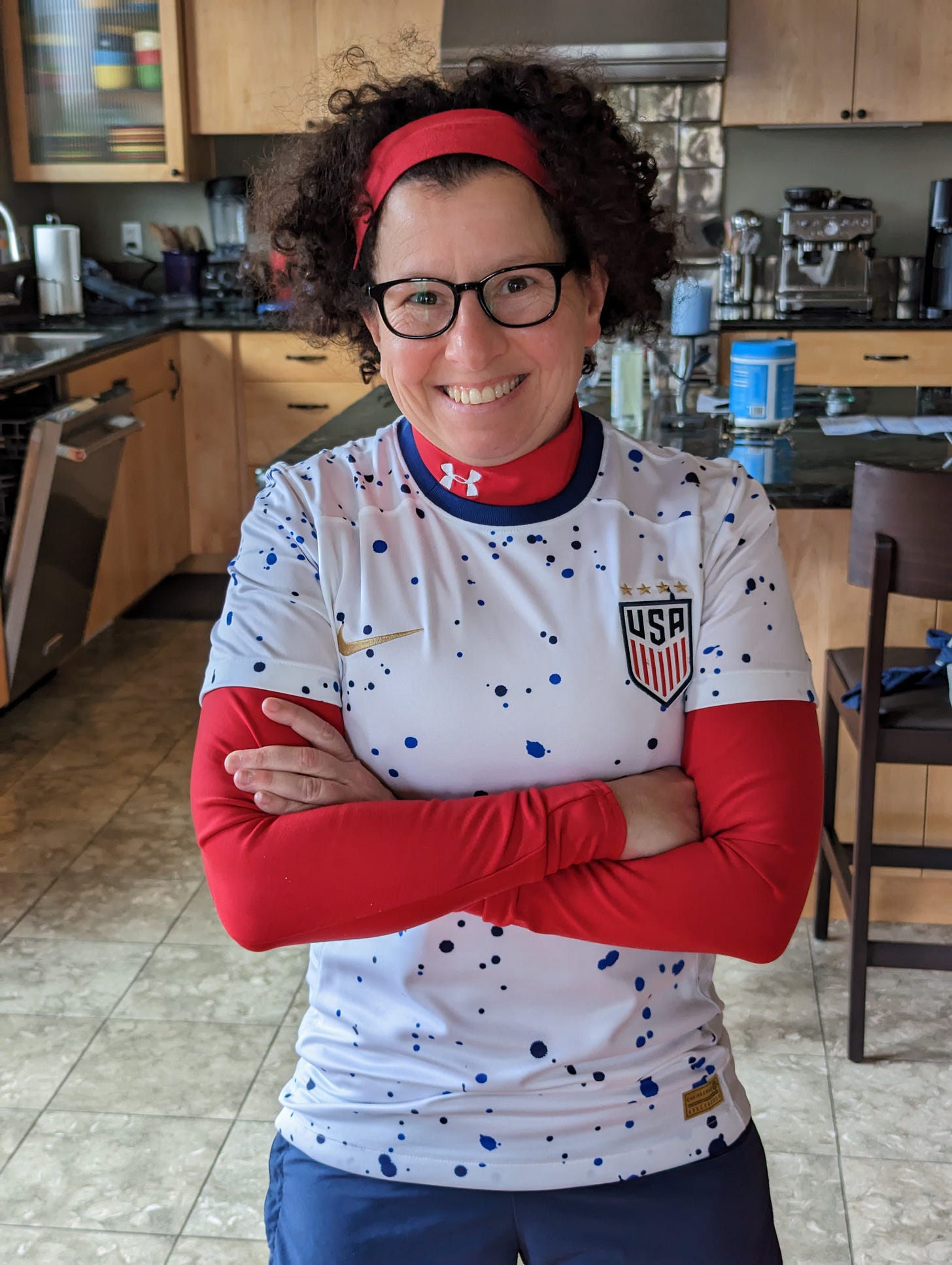[Estimated reading time: 3 minutes, 59 seconds - WHEW!]
Quick hit: I’m wearing my brand new US Soccer jersey for the upcoming Women’s World Cup starting next month. As a member of the US Soccer Development Council, I am proud to represent ALL of the US National Teams that comprise US Soccer. You’d be surprised at how many exist!
Next up: the USWNT roster drop in the next few days! I can’t wait!
[Disclaimer: You should not start a resistance training program without first checking with a doctor.]
This question came up recently at a focus group I was running. The back story is that the person asked their personal trainer for advice on “spot training” their abs. As most of us have found as we get older, fat tends to accumulate in the mid-section.
I want to bring this discussion to the fore. I have a safer approach to addressing this as this is a pretty common concern as you get older.
You have two things to think about when answering this question:
I want my flat stomach back.
I need to strengthen my core so I can continue to do the things I love doing as I get older.
Let’s go in order. For the 1st one, if you only focus on flattening your stomach, you won’t necessarily get a stronger core. My world was rocked by an interview in the New York Times back in 2004. They ran an interview with the author on the “South Beach Diet” and what resonated with me was:
If you get heart healthy, the other stuff (i.e., weight loss, less fatigue, etc.) will improve. But if you focus on weight loss only, you won’t necessarily improve your other biomarkers and fix your fatigue, etc. Anyone remember the term “skinny fat”?
That article changed the game for me. I picked up the actual book that day at Barnes & Noble. I then realized how little I knew about carbs and insulin sensitivity, and how my body reacted to it.
The book changed how I looked at food. Full stop. The name, “South Beach Diet”, sounds gimmicky, but it isn’t. I ate real food.
Result: Within 6 months, I was off of 2 very hard core pharmaceuticals related to my rheumatoid arthritis. Note that both of these were pulled from the market within the following 12-18 months for long-term side effects. And yes, my bodyweight went down but I was happier that my bloodwork improved and I was off of the drugs.
Like most journeys, mine was not linear and I had some ups and downs until I managed to get on a sustained path forward.
Now let’s get into #2, which is around strengthening your core.
Dr. Aaron Horschig’s book, “Rebuilding Milo”, (NERD ALERT!) talks about core exercises that will help with your back while also strengthening your core. Each of these have more advanced progressions as you become stronger.
Curl-up
Side plank
Bird dog
Video of all three movements is here.
When you focus on strengthening your core, you are going to move more efficiently and be able to do more of what you love and/or what you need to do on a daily basis.
Translation: You can be more active, which puts you in a better position to address any body composition goals you may have. Unfortunately, genetics likely plays a role in this as well.
This can be through lifting bags of soil in your garden or walking around Rome for hours on uneven streets. It does NOT need to be about lifting heavier in a gym.
Our previous coach, whom we still very much love, always says “every exercise is a core exercise”.
Short answer: SHE. IS. RIGHT.
We would talk about the concept called “hip cage”.
“Hip cage” is about assigning tension and stiffness through your middle. This allows you to engage your core throughout a movement instead of the lumbar spine (i.e., your back). Practically it means you pushing your hips and your ribs together to engage your core without hunching your back.
If you are doing some resistance training already, think about the “hip cage” concept while doing squats, lunges or overhead presses.
If you focus on engaging your core through every exercise, whether it is on the Peloton, lifting weights or doing bodyweight work, you will still strengthen your core while also working other muscles.
Translation: TWO FOR THE PRICE OF ONE!
Now taking what happened with me when I embarked on my “South Beach Diet” journey and flipping around the question from being task-focused on “how can I spot train my abs” to….
Something possibility-focused such as “imagine if you focused on adding strength to your core first, which could lead to other health benefits?”
Don’t spot train. You don’t have time for that.
Remember: Every exercise can be a core exercise, if you focus on your technique.
Get more bang for your buck because you’re busy AF.
I can help you find the right person to coach you while working within your time constraints and individual goals.
If you’re interested in learning more about how you can do resistance training without traditional equipment, reply to this email, like this post or comment below.
PS - Special thanks to Coach Lia for the previous advice and input for this post.




